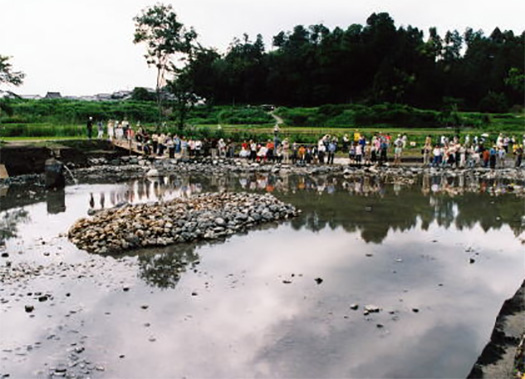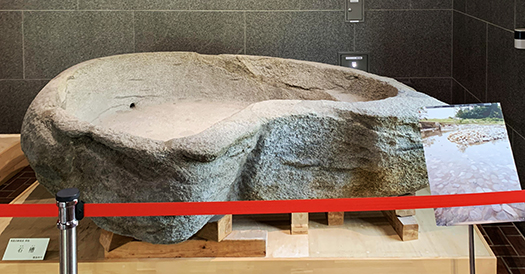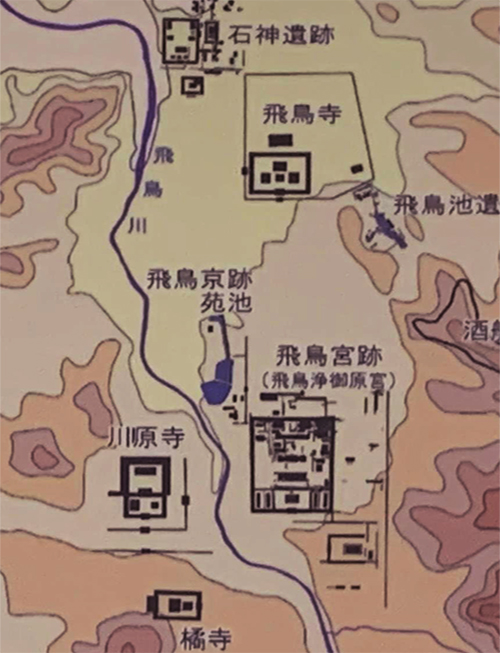


飛鳥宮が位置として特定された一帯は田園に変貌している。
今後、発掘調査が進展することで全貌がさらにあきらかにされ、
時間は掛かるけれど遺跡として保存される可能性が高い。
国の史跡保存にはさまざまな要件クリアが必要だろうが十分理解できる。
今の段階では鄙びた風景のなかから見学者が想像するしかない。
それはそれで土木工学的な演習として面白いのかも知れないけれど、
凡百としては遺跡としてわかりやすくなって欲しい。
一方でこういう都市が自然に還っていったような遺跡というのも
特異なありようとして現状を楽しむべきだとも思える。
写真は都城と飛鳥川の中間に造営「建設」された苑池の復元説明時の様子。
(写真と図は橿原考古博物館パネルより)
飛鳥浄御原宮想定地との関係はイラスト図のようであり、
発掘された石造物は苑池での水勢コントロール装置だという。
具体的にどのように機能したかは酒船石同様、よくわかっていない。
ただ、この「南池」は図のように桟敷板状平面があったようで、
そこには「噴水装置」も造作されていたとされているので、
その関連の石器造作だったと想像されている。
写真とイラストはほぼ同方向を意識して配置してみた。

宮廷建築・飛鳥浄御原宮との関連性で言えば、
たとえば東アジアからの国家賓客をこの苑池に案内して
「わが国ではこのように治水管理しています。
ごらんください、こちらからは人工的に噴水させています・・・」
みたいな技術力誇示として利用していたと思える。
国賓として接遇しつつも、さりげなく水源管理技術を見せて
「これは容易には征服戦争はできないな・・・」と思わせたのかも。
土木工事技術と石材加工技術の組み合わせで技術立国を目指していた。
この当時の瀬戸内海からの上陸地点と思える堺の地に
仁徳天皇陵を造営して初期には表面を石で被覆させていたと言われる。
白くまぶしいばかりの巨大石工技術構造物を見せることで
客人たちの脳裏に具体的な防衛産業力を見せつけていたことになる。
外交と国防の実質がこのように展開していたと想像できる。
日本は本格的な大陸国家による侵略戦争経験は少なく
第2次世界大戦での東京大空襲とか広島長崎への原爆攻撃に遭うまで
歴史年代を通して独立を維持し続けてきた。
たしかに海によって国境が区画され侵略者には兵站の困難があったにせよ、
このような不断の外交の積み重ねでの安全保障努力も大きかったに違いない。
そしてまた実際に水田への導水技術としての土木建築力は
もっとも大きな日本の伝統技術資産だとも思える。
こうした「苑池」を人工的に造作する技術体系が戦争技術となったら、
大きな防衛技術と見なされたことも疑いない。
「この治水・土木技術があれば容易ならざる防衛城郭技術も可能だ・・・」と。
和を以て貴しとなす平和理念を外交の基本としつつも
昔人は国防をリアリズムで考え観念論など一顧だにしなかった・・・。
English version⬇
The Role of Asuka Palace’s “Garden Pond” as a National Defense Measure: Exploring Asuka, Nara – 4
Civil engineering and flood control technology to manage water, and by extension, peaceful national defense efforts to show military national defense capabilities and crush the aggressive intentions of potential enemies. …
It seems to me that they were using it as a show of their technological prowess.
While treating them as guests of honor, he casually showed them his water source management technology.
Perhaps it was to make them think, “This is not an easy war of conquest.
The combination of civil engineering technology and stone processing technology was aimed at making the country a technological power.
In Sakai, which seems to be the landing place from the Seto Inland Sea at that time.
It is said that they built Emperor Nintoku’s mausoleum and had the surface covered with stone in the early days.
By showing huge masonry engineering structures in dazzling white
It would have shown concrete defense industrial power in the minds of the guests.
One can imagine the substance of diplomacy and national defense unfolding in this way.
Japan had little experience with full-scale continental state wars of aggression.
Until the air raid on Tokyo in World War II and the atomic bombing of Hiroshima and Nagasaki
Throughout historical eras, the country has maintained its independence.
While it is true that borders were demarcated by sea, making logistics difficult for the invaders, the country has nevertheless maintained its independence throughout its history.
The security efforts made through such tireless diplomacy must have been significant.
And the civil engineering and architectural capabilities that actually led the water to the rice paddies must have been a major factor in the development of the country.
It seems to me that this is one of Japan’s most significant traditional technological assets.
If the technical system to artificially create such “garden ponds” were to become a war technology, it would be a great asset.
There is no doubt that it would have been considered a major defense technology.
With this flood control and civil engineering technology, it would be possible to create defensive fortifications, which is not an easy task…”
While the peace philosophy of “harmony is precious” is the basis of diplomacy
People in the past thought of national defense with realism and never gave a second thought to idealism.
Posted on 4月 19th, 2022 by 三木 奎吾
Filed under: 住宅マーケティング, 日本社会・文化研究







コメントを投稿
「※誹謗中傷や、悪意のある書き込み、営利目的などのコメントを防ぐために、投稿された全てのコメントは一時的に保留されますのでご了承ください。」
You must be logged in to post a comment.